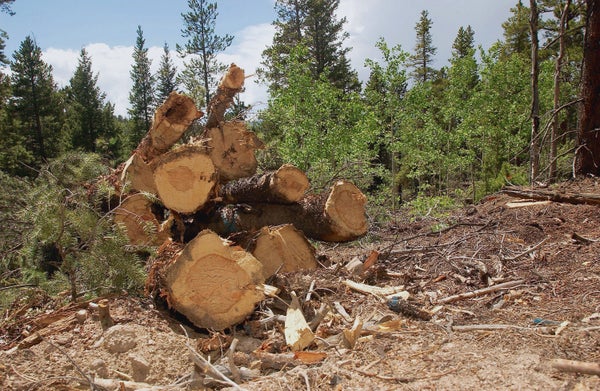CLIMATEWIRE | Activists are condemning a recent Forest Service report to Congress, saying one of its conclusions supports a policy that would worsen climate change by allowing the removal of old trees that absorb large amounts of carbon.
Some climate scientists and environmental groups say the Forest Service report inaccurately states that older trees remove less carbon than younger trees — a conclusion they fear will encourage a policy of logging older forests.
The report is “a camel’s nose in the door” that could lead to more logging, said Norman Christensen, a professor at Duke University’s Nicholas School of the Environment.
On supporting science journalism
If you're enjoying this article, consider supporting our award-winning journalism by subscribing. By purchasing a subscription you are helping to ensure the future of impactful stories about the discoveries and ideas shaping our world today.
The Forest Service wrote in July that U.S. forests will rapidly lose their ability to soak up carbon and could become net carbon emitters by 2070 instead of carbon sinks. The report says development along with worsening wildfires and tornadoes will destroy large chunks of U.S. forests and disrupt their carbon absorption.
The report also says aging forests absorb less carbon than younger forests as tree growth slows.
But some climate scientists and environmental groups consider the conclusion misleading and largely inaccurate.
“The idea of cutting trees to let small trees come in is problematic,” Christensen said. “Anything you cut is … going to be turning into carbon dioxide.”
The debate around the ability of older forests to offset emissions could influence the Biden administration’s forest conservation policy.
The Forest Service is now drafting new federal rules to better manage forests and grasslands for climate resiliency. President Joe Biden issued an executive order in April 2022 directing the agency to define and protect mature forests to reach his climate goals.
The agency’s recent report could justify new policies that allow logging of old trees, said Carolyn Ramírez, a staff scientist at Natural Resources Defense Council. Such a policy would be misguided, Ramírez said, because old trees still absorb large amounts of emissions and release carbon when they are cut down.
Climate groups and the Forest Service agree that forests are crucial in storing carbon and countering greenhouse gas emissions. But they differ in how the government should manage the millions of acres of forests it oversees. The Forest Service manages 193 million acres of public land — an area roughly the size of Texas — including forests, grasslands and wetlands.
Some activists and ecologists say the Forest Service should let trees reach old age.
The NRDC said in recent comments to the Forest Service that studies show older trees “will continue to absorb carbon at an increasing rate, storing carbon faster than younger trees do.”
Douglas fir forests in Washington state and Oregon captured more carbon in their second century of growth than in their first century, Jerry Franklin, a forest ecology professor at the University of Washington, said in an interview.
Mature forests sustain less damage from wildfires and store carbon longer because their large tree canopies create moist environments that hinder the spread of flames, Christensen of Duke University said.
The Forest Service says active forest management including “strategic thinning” reduces wildfire damage that turns forests into carbon emitters. The agency could cut down a few trees to decrease forest density, which would let forests store more carbon after a fire, Forest Service spokesperson John Winn said in an email.
A 2008 study conducted by researchers at Northern Arizona University concluded that forest thinning could ease wildfire damage by reducing the number of trees that can burn, allowing forests to store more carbon.
The Forest Service's July report “is based in sound science” and provides “a scientific assessment” that can be used in future policy discussions on managing U.S. forests, Winn said.
“We do not make any forest management prescriptions in the report,” Winn noted.
The 348-page report measures renewable resources such as water and in the nation’s forests and in other undeveloped landscapes and predicts changes in the next 50 years. Congress mandates the decennial report and in 1990 added a requirement to study climate impacts on forests and rangelands.
The Forest Service oversees timber sales in public lands, selling between $100 million and $300 million worth of timber every year from fiscal year 2001. The money goes into various Forest Service funds.
The Forest Service mission emphasizes balancing preservation with resource extraction, including ensuring stable lumber production from national forests. Its decennial report informs Congress how the U.S. could manage its undeveloped land.
The Forest Service “absolutely does have a conflicting mandate,” said Zack Porter, executive director at conservation nonprofit Standing Trees. “Our forestry schools teach people how to grow trees as a crop. In 2023, we can't keep looking at our forests that way, especially our public forest.”
Randi Spivak, director of the public lands program at Center for Biological Diversity, says the Forest Service rewards employees for meeting lumber production effectively encouraging the logging of older trees,
“The larger and older the tree, the broader the board feet produced,” Spivak said.
As recently as January 2023, the Forest Service proposed opening 12,000 acres of the Green Mountain National Forest in Vermont — a popular hiking area — to logging.
The Forest Service aims to balance “diverse needs of people” in managing its lands under federal law, said Winn, the Forest Service spokesperson. “These laws form our directives and policies on how we manage national forests and grasslands.”
Reprinted from E&E News with permission from POLITICO, LLC. Copyright 2023. E&E News provides essential news for energy and environment professionals.
